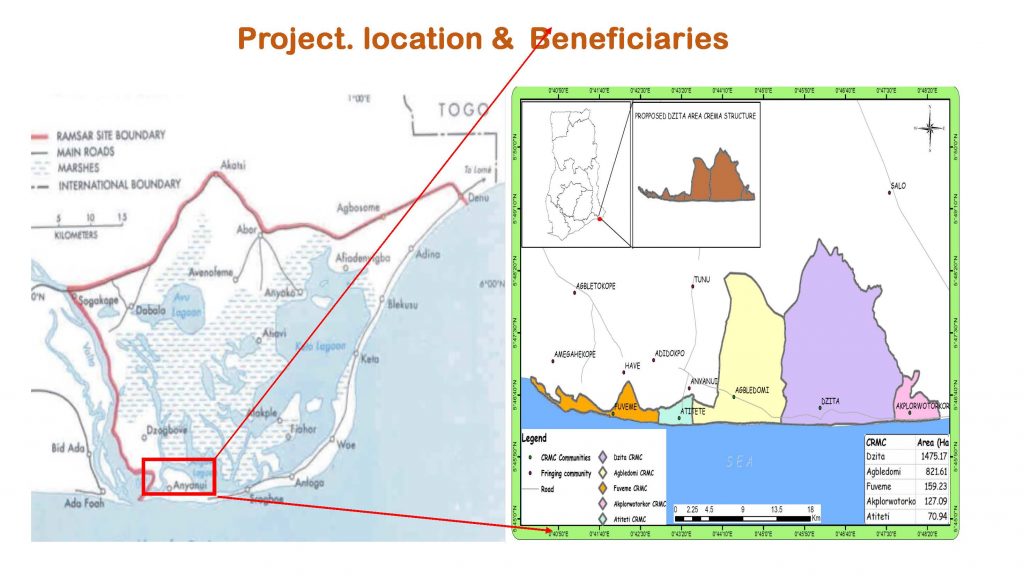
Strengthening local participation in Mangrove conservation and restoration
BACKGROUND
The largest wetlands in Ghana, the Anlo Keta Lagoon Complex Ramsar Site (AKLCRS), was named a Ramsar site in 1992. It includes islands and a portion of the Volta River estuary. Its purpose is to preserve and increase the value of the wetland as a habitat for wildlife, particularly migrating birds and for the preservation of wetland resources as well. Due to deforestation, overuse of mangroves, pollution; particularly plastics, the effects of climate change, drought, flooding, and inadequate spatial development, the site is losing both its integrity and its size.
The Development Institute, an NGO in Ghana and member of the IUCN with fifteen(15) years of experience in the AKLCRS, intervened with assistance from the EU through IUCN PACO.
The goal of this initiative was to establish community mangrove organizations as visible institutions and give them access to contemporary instruments for mangrove restoration.
SPECIFIC OBJECTIVES
● To strengthen the governance and management structure of existing eight (8) mangrove community institutions and local user groups in the four (4) selected communities.
● To build capacity and empower communities in sustainable management of mangrove species within the target areas.
ACHIEVEMENTS
● Following a full year of intervention, the governance and management structures of eight (8) community institutions and local user groups had been strengthened, and the communities had gained the knowledge, abilities, and support necessary to reestablish and regulate the use of mangrove species (Avicennia and Rhizophora) and related plants.
● As a result of the initiative, mangrove teams were established, equipped to monitor the health of the ecosystem and restore degraded mangrove regions.
● Innovative techniques for conservation and mangrove restoration are offered to the targeted people and communities.
CHALLENGES
● The project’s first major issue was the siltation of the Volta River estuary and channels, which limited the field’s ability to be salinized and subjected to high and low time regimes, which hindered the establishment of seedlings.
●The second issue was the Volta dam’s overflowing water, which caused newly planted seedlings to be carried off.
MAJOR ACTIVITIES UNDERTAKEN
● As part of a capacity-building project, thirty-two leaders of mangrove community institutions and users organizations attended a two-day residential training on institutional governance and administration.
● Encouraged the establishment of community method demonstration fields and assist in community plot negotiations in each of the four communities that are being targeted.
● Propagule gathering, storing, and organization of community mangrove teams.
● Through monitoring and review meetings, the project’s experiences, lessons learned, procedures, and outcomes were recorded for dissemination both nationally and worldwide.
UNFORESEEN OUTCOMES OBTAINED
● Individuals in the community have begun to establish their own private nurseries. They aim to plant some and sell it to the highest bidder.
● The District Assembly delegates have been requested by the communities’ CREMA to support their mangrove restoration efforts by supplying well-fed seedlings.
● The communities’ traditional leaders have taken on a great deal of responsibility and are actively supporting the cause. They have called gatherings and hosted them in their homes and compounds, among other methods.
ACHIEVEMENT TALE.
● A resident of Akplowotokor and a member of the Community Mangrove Team, Ganyo Tay, established a nursery in one of the streams and raised over 2000 seedlings there.
● A nursery has also been established in the village by Dzita, Francis Azadagli, where he has planted seedlings in plastic bags that have been filled with soil. He’s trying to grow his nursery right now.
● In order to promote mangrove restoration in the four communities, the Community Mangrove Teams—which were originally formed to oversee community plots—have evolved into an institution. They are able to consult with any institution that approaches the CREMA with matters pertaining to mangrove restoration. They are currently in the lead.
MAINTAINING THE COURSE OF ACTIVITY.
Based on our assessment, every action made during the project’s execution was significant and would be continued in the post-project phase as well as in any future projects that are implemented in the mangrove area’s communities. Development has taken place for the ongoing activities.